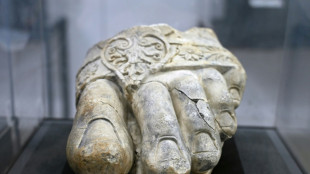
-
 At least 24 killed in Kashmir attack on tourists
At least 24 killed in Kashmir attack on tourists
-
Rahul powers Delhi to big win over Lucknow in IPL

-
 Colombian cycling star 'Lucho' Herrera denies murder conspiracy
Colombian cycling star 'Lucho' Herrera denies murder conspiracy
-
Trump, Zelensky to attend Pope Francis's funeral Saturday

-
 US State Department to cut positions, rights offices
US State Department to cut positions, rights offices
-
Ukraine ready for direct talks with Russia only after ceasefire: Zelensky

-
 Myanmar Catholics mourn pope who remembered their plight
Myanmar Catholics mourn pope who remembered their plight
-
Pope's Vatican 'family' pay tearful respects

-
 The world leaders set to attend Pope Francis's funeral
The world leaders set to attend Pope Francis's funeral
-
'Like a storm': Witnesses describe deadly Kashmir attack

-
 Volkswagen unveils its electric counter-offensive in China
Volkswagen unveils its electric counter-offensive in China
-
Landmark Nepal survey estimates nearly 400 elusive snow leopards

-
 Napoleon letter auction recalls French pope detention
Napoleon letter auction recalls French pope detention
-
Saka injury 'nothing serious' as Arteta weighs Arsenal options

-
 Rubio to cut positions, rights offices at US State Department
Rubio to cut positions, rights offices at US State Department
-
Trump says 'on the same side of every issue' with Netanyahu after call

-
 ECB's Lagarde hopes Trump won't fire US Fed chief Powell
ECB's Lagarde hopes Trump won't fire US Fed chief Powell
-
Gold hits record as Trump fuels Fed fears, Wall Street rebounds

-
 The world leaders set to attend Francis's funeral
The world leaders set to attend Francis's funeral
-
East Timor mourns Pope Francis months after emotional visit

-
 US envoy to visit Moscow as US pushes for ceasefire
US envoy to visit Moscow as US pushes for ceasefire
-
At least 24 killed in Kashmir attack on tourists: Indian police source

-
 Philippine typhoon victims remember day Pope Francis brought hope
Philippine typhoon victims remember day Pope Francis brought hope
-
IMF slashes global growth outlook on impact of Trump tariffs

-
 BASF exits Xinjiang ventures after Uyghur abuse reports
BASF exits Xinjiang ventures after Uyghur abuse reports
-
Nordics, Lithuania plan joint purchase of combat vehicles

-
 Gold hits record, stocks diverge as Trump fuels Fed fears
Gold hits record, stocks diverge as Trump fuels Fed fears
-
World could boost growth by reducing trade doubt: IMF chief economist

-
 IMF slashes global growth outlook on impact of US tariffs
IMF slashes global growth outlook on impact of US tariffs
-
IMF slashes China growth forecasts as trade war deepens

-
 Skipper Shanto leads Bangladesh fightback in Zimbabwe Test
Skipper Shanto leads Bangladesh fightback in Zimbabwe Test
-
US VP Vance says 'progress' in India trade talks

-
 Ex-England star Youngs to retire from rugby
Ex-England star Youngs to retire from rugby
-
Black Ferns star Woodman-Wickliffe returning for World Cup

-
 Kremlin warns against rushing Ukraine talks
Kremlin warns against rushing Ukraine talks
-
Mbappe aiming for Copa del Rey final return: Ancelotti

-
 US universities issue letter condemning Trump's 'political interference'
US universities issue letter condemning Trump's 'political interference'
-
Pope Francis's unfulfilled wish: declaring PNG's first saint

-
 Myanmar rebels prepare to hand key city back to junta, China says
Myanmar rebels prepare to hand key city back to junta, China says
-
Hamas team heads to Cairo for Gaza talks as Israel strikes kill 26

-
 Pianist to perform London musical marathon
Pianist to perform London musical marathon
-
India's Bumrah, Mandhana win top Wisden cricket awards

-
 Zurab Tsereteli, whose monumental works won over Russian elites, dies aged 91
Zurab Tsereteli, whose monumental works won over Russian elites, dies aged 91
-
Roche says will invest $50 bn in US, as tariff war uncertainty swells

-
 Pope Francis's funeral set for Saturday, world leaders expected
Pope Francis's funeral set for Saturday, world leaders expected
-
US official asserts Trump's agenda in tariff-hit Southeast Asia

-
 World leaders set to attend Francis's funeral as cardinals gather
World leaders set to attend Francis's funeral as cardinals gather
-
Gold hits record, stocks mixed as Trump fuels Fed fears

-
 Roche says will invest $50 bn in US over next five years
Roche says will invest $50 bn in US over next five years
-
Fleeing Pakistan, Afghans rebuild from nothing


Discovery of tiny bone sheds light on mysterious 'hobbit' humans
The discovery of a tiny arm bone suggests that an ancient human dubbed "hobbits" only shrank down to their diminutive size after they arrived on an Indonesian island a million years ago, scientists said on Tuesday.
Much about the pint-sized Homo floresiensis has been shrouded in mystery since the first fossils suggesting their existence were found on the island of Flores in 2003.
These tool-using hominins are believed to have been living on the island as recently as 50,000 years ago, when our own species homo sapiens was already walking the Earth, including in nearby Australia.
From some 60,000-year-old teeth and a jawbone found in an island cave, scientists had previously estimated the hobbits were around 1.06 metres (3.5 feet) tall.
But the discovery of part of an upper arm bone as well as some teeth at an open-air island site on the island suggests some hobbits stood just one metre tall around 700,000 years ago, according to a study in the journal Nature Communications.
The bone was so small, that at first the international team of researchers thought it must have been from a child.
Study co-author Adam Brumm, an archaeologist at Australia's Griffith University, told AFP that it was the smallest humerus fossil of an adult hominin ever found.
- 'Truly epic' -
The discovery could tip the scales in a heated debate among scientists about how H.floresiensis became so small.
One side argues that the hobbits -- nicknamed after the little heroes in JRR Tolkien's fantasy novels -- descended from an already small earlier hominin which arrived on Flores around a million years ago.
Others believe that it was our ancestor Homo erectus, which were roughly our size and had spread throughout Asia, that became trapped on the island, only to then evolve into the smaller H.floresiensis over the next 300,00 years.
The researchers behind the latest discovery believe it strongly supports the latter theory.
These ancient humans "reduced drastically in body size according to a well known evolutionary phenomenon known as island dwarfism," Brumm said.
Under this process, larger animals tend to shrink over time to adapt to their limited surroundings.
The tropical island was home to other smaller-than-normal mammals, including a cow-sized relative of the elephant.
The newly discovered teeth also look like smaller versions of those from Homo erectus, the researchers said.
"If we are correct, it seems that Homo erectus was somehow able to cross formidable deep-sea barriers to reach isolated islands like Flores," Brumm said.
"We don't know how they were doing this," he said, adding that "accidental 'rafting' on tsunami debris" was one possibility.
Once these ancient humans were trapped on the island, they managed to survive for hundreds of thousands of years, evolving into "strange new forms," Brumm said.
Mark Moore, an archaeologist at Australia's University of New England not involved in the study, said the discovery means "we can now confidently say" that the Homo erectus theory is the more likely scenario.
Moore, who has studied the stone tools used by the hobbits, told AFP that this "technology did not shield our cousin species from the forces of biological evolution".
That the hobbits changed so much over just 300,000 years was "a reminder of the power of natural selection," he added.
"The evolutionary story of this group of hominins is truly epic."
R.Buehler--VB


